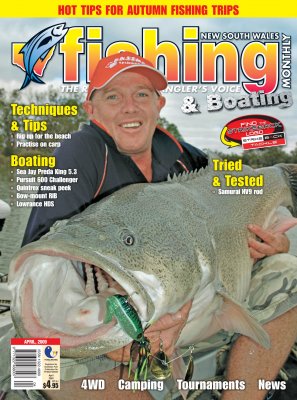Rigging up for the beach by Jamie Robley
 Autumn is a perfect time of year for beach fishing along the NSW coastline because every target species is active, so it's rare to wait for long between bites.
Autumn is a perfect time of year for beach fishing along the NSW coastline because every target species is active, so it's rare to wait for long between bites.
Tailor, jewfish and bream are really peaking right now and there's still a good chance of tangling with big salmon, whiting, flathead, dart and others.
Depending on which type of fish you want to catch and the nature of your local beach, there are basically three different styles of gear that can be used to good effect.
A light set-up is ideal for bream, whiting and flathead, a mid-weight outfit is for tailor or salmon and the big gear is for jewfish, sharks or bigger tailor (which aren't uncommon at this time of year).
Suitable lines and rigs for each category of beach fishing may also differ so let's take a closer look at light, medium and heavy gear for the beach.
LIGHT OUTFIT
For many years I've enjoyed using what's often called a flick stick for the lighter side of beach fishing.
In other words, I take to the beach a small rod and reel combo that most would consider to be right at home in the local estuary for bream.
Although there are small Alvey reels on the market that could be put to use for this side of beach fishing, a small threadline is perhaps easier to use and offers a bit more versatility.
A 2000 to 3000 size threadline spooled up with 3kg to 5kg line can be teamed up with a rod of around 2.2m. Either graphite or glass rods will work but the tip section should be light enough to feel bites in the surf and the rod should be capable of casting out at least a size 5 or 6 ball sinker if need be.
For the most part, though, smaller sinkers like a size 4 ball are right on the mark when tossing small baits just beyond the shore dump - where the fish hang.
MIDDLE WEIGHT
This is perhaps the most versatile category which the majority of beach anglers would benefit from using.
Threadline or sidecast reels will do a good job when matched to a 3m to 3.6m rod that can cast out a whole pilchard on ganged hooks along with a size 7 or 8 ball sinker or similar weight.
For many years the standard type of rod for this class of beach fishing has been what's known as a '6144' or '7144'. Without getting right into technicalities, that roughly equates to a 3.6m rod with a light, whippy tip.
These days, however, there are a lot more rods to choose from and all the big brand names have a number of such rods in their ranges. Most of them are quite light and are fitted with quality components.
Suitable sidecast reels would include most of the 600 models and those lighter, graphite-back models like the 600B are right on the mark. Threadline reels in sizes from 4000 up to 6000 are also light and are a joy to use when tangling with tailor and salmon. Lines from 5kg to 8kg cast well and are the way to go in the middleweight category.